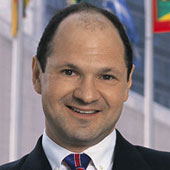The Drugstore Capital of the World
How did the pharmacy giants turn into major players in New York City’s new drug war?
May 14, 2001
New York’s largest drugstore company, Duane Reade, has over 100 pharmacies in Manhattan alone. Rite Aid lists 36 on its website — and CVS, a relative newcomer to the city, has 22. More are opening up every day. Little wonder that the commercial space in all those new apartment buildings that are currently mushrooming all over the city is typically pre-leased to one of those three chains.
Plus there are other chains and numerous independent, mom-and-pop pharmacies. The amazing thing is that there seems to be plenty of demand for all of them to stay in business. But given the spread of disease through globalization, on second thought, it is perhaps less surprising.
New York City is the traditional gateway to America for immigrants and tourists. As such, it is not only a melting pot of global cultures — but of all sorts of nasty viruses, bugs and contagions. Who would be surprised if, riding the city’s ancient subway system, the man standing next to you was harboring the Asian flu, the person next to him the West Nile Virus — and the person next to him German measles?
New York’s solution? More drugstores, the city’s newest trend. And all of this is, of course, fairly typical of New York City. Some new trend emerges, and pretty soon it seems that every storefront becomes devoted to it.
Back in the 1960s, Mick Jagger of the Rolling Stones wrote a song that had the following lines: “Went down to a Chelsea drug store/To get my prescription filled.” In the era of sex, drugs and rock ‘n’ roll, one can only imagine what kind of prescription that was.
Today, Mr. Jagger makes his home in New York, not London. As he approaches his 60th birthday, he probably needs to think of a more conventional type of prescriptions.
And this trend towards a city-wide drug(store) war makes sense from a demographic point of view. Back in the 1980s, baby boomers streamed into New York City, having just graduated from college. Well-acquainted with international fashion, they wanted to dress well, but didn’t have too much money. Italy’s youthful clothing manufacturer, Benetton, fit the bill nicely — and its stores sprouted up throughout the city.
Then, in the 1990s the baby boomers settled down to work. They needed their steady dose of espresso and cafe latte — as they worked late into the night on those corporate mega-merger deals. Of course, in keeping with their sweeping worldview, they went in for global coffees — the Kenya highland blend or the Sumatra roast. Now, most of the coffee bars that dealt these global blends have been taken over by Starbucks.
Now, New Yorkers are enamored with drugstores. Why? Simple, the baby boom generation is aging. They start to need over-the-counter and prescriptions drugs to deal with the creeping middle age and its ailments — not to mention the antacids for the ups and downs of the tipsy-topsy stock market.
So as the challenges of globalization get tougher, apparently so do the remedies. If it was coffee that was the “gasoline” that kept New Yorkers going in the 1990s, then perhaps it now is drugs — of course, just of the legal variety — that will keep them going in the 2000s.
Read previous
An American in Paris
May 11, 2001
